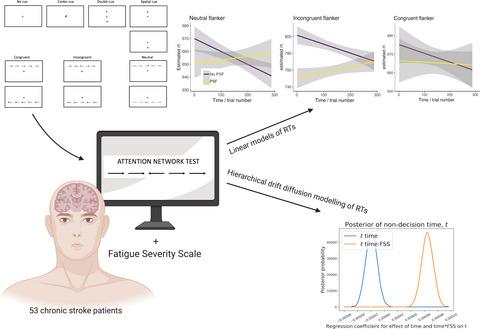当前位置:
X-MOL 学术
›
Eur. J. Neurosci.
›
论文详情
Our official English website, www.x-mol.net, welcomes your
feedback! (Note: you will need to create a separate account there.)
Dissecting the cognitive phenotype of post‐stroke fatigue using computerized assessment and computational modeling of sustained attention
European Journal of Neuroscience ( IF 2.7 ) Pub Date : 2020-06-12 , DOI: 10.1111/ejn.14861 Kristine M. Ulrichsen 1, 2, 3, 4 , Dag Alnæs 1, 2 , Knut K. Kolskår 1, 2, 3, 4 , Geneviève Richard 1, 2, 3, 4 , Anne‐Marthe Sanders 1, 2, 3, 4 , Erlend S. Dørum 1, 2, 3, 4 , Hege Ihle‐Hansen 5 , Mads L. Pedersen 3, 6 , Sveinung Tornås 4 , Jan E. Nordvik 7 , Lars T. Westlye 1, 2, 3, 8
European Journal of Neuroscience ( IF 2.7 ) Pub Date : 2020-06-12 , DOI: 10.1111/ejn.14861 Kristine M. Ulrichsen 1, 2, 3, 4 , Dag Alnæs 1, 2 , Knut K. Kolskår 1, 2, 3, 4 , Geneviève Richard 1, 2, 3, 4 , Anne‐Marthe Sanders 1, 2, 3, 4 , Erlend S. Dørum 1, 2, 3, 4 , Hege Ihle‐Hansen 5 , Mads L. Pedersen 3, 6 , Sveinung Tornås 4 , Jan E. Nordvik 7 , Lars T. Westlye 1, 2, 3, 8
Affiliation

|
Post‐stroke fatigue (PSF) is prevalent among stroke patients, but its mechanisms are poorly understood. Many patients with PSF experience cognitive difficulties, but studies aiming to identify cognitive correlates of PSF have been largely inconclusive. With the aim of characterizing the relationship between subjective fatigue and attentional function, we collected behavioral data using the attention network test (ANT) and self‐reported fatigue scores using the fatigue severity scale (FSS) from 53 stroke patients. In order to evaluate the utility and added value of computational modeling for delineating specific underpinnings of response time (RT) distributions, we fitted a hierarchical drift diffusion model (hDDM) to the ANT data. Results revealed a relationship between fatigue and RT distributions. Specifically, there was a positive interaction between FSS score and elapsed time on RT. Group analyses suggested that patients without PSF increased speed during the course of the session, while patients with PSF did not. In line with the conventional analyses based on observed RT, the best fitting hDD model identified an interaction between elapsed time and fatigue on non‐decision time, suggesting an increase in time needed for stimulus encoding and response execution rather than cognitive information processing and evidence accumulation. These novel results demonstrate the significance of considering the sustained nature of effort when defining the cognitive phenotype of PSF, intuitively indicating that the cognitive phenotype of fatigue entails an increased vulnerability to sustained effort, and suggest that the use of computational approaches offers a further characterization of specific processes underlying behavioral differences.
中文翻译:

使用持续注意力的计算机评估和计算模型剖析中风后疲劳的认知表型
脑卒中后疲劳(PSF)在中风患者中普遍存在,但其机制尚不清楚。许多患有PSF的患者遇到认知困难,但是旨在鉴定PSF认知相关性的研究在很大程度上尚无定论。为了表征主观疲劳与注意功能之间的关系,我们使用注意力网络测试(ANT)收集了行为数据,并使用了疲劳严重程度量表(FSS)收集了来自53名卒中患者的自我报告的疲劳评分。为了评估用于描述响应时间(RT)分布的特定基础的计算模型的效用和附加值,我们对ANT数据拟合了分层漂移扩散模型(hDDM)。结果揭示了疲劳与RT分布之间的关系。特别,FSS评分与RT消逝时间之间存在正相关。小组分析表明,没有PSF的患者在疗程中速度加快,而PSF的患者则没有。与基于观察到的RT的常规分析一致,最佳拟合的hDD模型确定了经过时间与疲劳在非决策时间上的相互作用,这表明刺激编码和响应执行而不是认知信息处理和证据积累所需的时间增加了。这些新颖的结果证明了在定义PSF的认知表型时考虑努力的持续性的重要性,直观地表明疲劳的认知表型导致持续努力的脆弱性增加,
更新日期:2020-07-13
中文翻译:

使用持续注意力的计算机评估和计算模型剖析中风后疲劳的认知表型
脑卒中后疲劳(PSF)在中风患者中普遍存在,但其机制尚不清楚。许多患有PSF的患者遇到认知困难,但是旨在鉴定PSF认知相关性的研究在很大程度上尚无定论。为了表征主观疲劳与注意功能之间的关系,我们使用注意力网络测试(ANT)收集了行为数据,并使用了疲劳严重程度量表(FSS)收集了来自53名卒中患者的自我报告的疲劳评分。为了评估用于描述响应时间(RT)分布的特定基础的计算模型的效用和附加值,我们对ANT数据拟合了分层漂移扩散模型(hDDM)。结果揭示了疲劳与RT分布之间的关系。特别,FSS评分与RT消逝时间之间存在正相关。小组分析表明,没有PSF的患者在疗程中速度加快,而PSF的患者则没有。与基于观察到的RT的常规分析一致,最佳拟合的hDD模型确定了经过时间与疲劳在非决策时间上的相互作用,这表明刺激编码和响应执行而不是认知信息处理和证据积累所需的时间增加了。这些新颖的结果证明了在定义PSF的认知表型时考虑努力的持续性的重要性,直观地表明疲劳的认知表型导致持续努力的脆弱性增加,











































 京公网安备 11010802027423号
京公网安备 11010802027423号